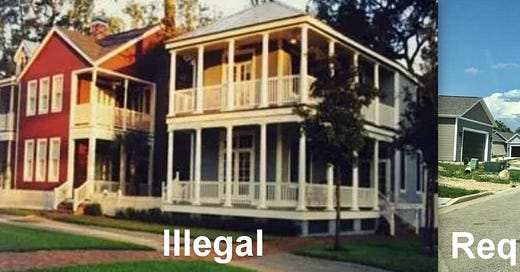Building Neighborhoods that We Love is Now Illegal
A friend on Facebook posted a comment about comparison photos I had placed on Facebook showing how a walkable, compact, low-speed street was illegal and a massive parking lot shopping center was required by land development codes. He offered the thought that walkable design was illegal due to the “auto lobby” or corruption.
I responded that this was perhaps true initially.
But for over a century, we have met the enemy and he/she is us. We have become our own worst enemies because of our motor vehicle-based lifestyles. We are compelled to adopt such a lifestyle because travel by motor vehicle is highly inconvenient and costly if it occurs in a compact, walkable community.
Instead, since the car emerged, we angrily and understandably demand designing for happy cars rather than happy people. That is, our lifestyles require us to insist that our elected officials give us dispersed, low-density community patterns. Patterns that are more conducive to car travel. Patterns that can only be navigated by car. Patterns that, ironically, lead to unhappy people.
Unfortunately, the motorized travel we are obligated to demand is a zero-sum, self-perpetuating, downward, vicious cycle.
That is, motor vehicles are far higher speed and far larger than what makes for a healthy city. Because we so eagerly became owners and users of the miraculous motor vehicle over the past century, we aggressively pushed our elected officials to create dispersed, low-density, high-speed places.
Again, we were forced to do that, as such design is the only way our motor vehicles can avoid putting us in frustrating traffic congestion.
Unfortunately, not only are we therefore locked into a design that kills a city (cities thrive in compact, human-scaled, lower-speed designs and are destroyed with higher-speed, low-density designs), we are thereby also locked into demanding roads and parking that makes congestion and parking worse (you cannot widen your way out of road or parking congestion).
Congestion worsens in part because dispersed, car-based design inevitably requires a larger percentage of community residents to travel by car. In addition, a growing percentage of daily trips are now obligated to be by car.
Tragically, that low-density, high-speed design we furiously demand comes nowhere near paying for itself (which means cities are states suffer financial woes and are obligated to forever increase taxes). This design has also made it unaffordable for households, largely because most households cannot afford to own 2-5 cars. The drivable design, therefore, makes affordable housing impossible.
Oh, and those speedy cars we now use for travel? The community dispersal caused by car travel means we now are forced to allocate more time to daily travel than we did a century ago when we mostly walked to our daily destinations. Why? Because it is faster to walk 2 mph to a store in the neighborhood than to drive 45 mph to a store 10 miles away.
Consider the Mapleton Hill neighborhood battle in Boulder CO against a senior care facility a few years ago. One of the biggest fears of neighborhood residents was "spillover" parking from the facility. I failed to convince any of those activists that parking was the wrong battle. They should have been fighting for a charming, human-scaled, low-speed village design. By fighting against parking, they instead got over-priced senior housing, and suburban, unwalkable, over-provided parking lots.
I like to point out as often as I can the fact that in nearly all cities, including Mapleton Hill in Boulder and Hampton-Pinckney in Greenville SC, it is the historic neighborhoods that are the most loved neighborhoods in cities that are unlawful. The result is that citizens have succeeded in convincing their elected officials to make it illegal to build the most loved neighborhood in their city.
The developer would be prevented from building what most citizens love most because the setbacks are too small (for cars). The density is too high (for cars). The parking is insufficient (for cars). The houses are too tall (for cars). Street dimensions are too low-speed (for cars). Granny flats are prohibited (too much density for cars). Small shops and grocers and neighborhood-based pubs are verboten in the neighborhood (not enough parking for cars). Picturesque and romantic canopy street trees cannot be planted because suburban arborists insist on tree diversity (nearly all arborists live a car-based lifestyle).
To add insult to injury, architecture schools ensure that house design will be unlovable modernist rather than timelessly charming and romantic.
In the unlikely event that a front porch is installed, that porch must not be at a conversational distance from the sidewalk; instead, those walking on the sidewalk tend to never see a neighbor on their distant porch because the porch is too far from the sidewalk. In the rare instances where they do see such a neighbor (probably because they happened to have binoculars), a bullhorn is required to talk to someone on that scarce porch.





